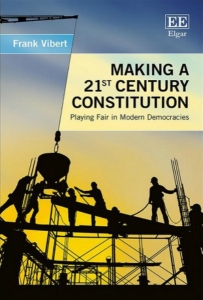Book Review | Making a 21st Century Constitution: Playing Fair in Modern Democracies by Frank Vibert
In Making a 21st Century Constitution: Playing Fair in Modern Democracies, Frank Vibert explores the current state of constitutions, outlining why they have become outdated and suggesting ways in which they can be reworked to better meet the needs of democracies today. While readers may not agree with all of the book’s arguments, it provides interesting insight into how constitutions can overcome their democratic weaknesses and is a welcome addition to this increasing body of scholarship, finds Elyse Wakelin.

Parchment rolls of historical acts of Parliament. Picture: Jeroen van Luin, via a (CC BY 2.0)
Making a 21st Century Constitution: Playing Fair in Modern Democracies. Frank Vibert. Edward Elgar. 2018.
 The publication of Frank Vibert’s account of the making of the modern constitution could not be more timely, with the relevance of constitutions to the current political climate indisputable. Across the globe, there are ongoing events which raise questions as to the strength of current constitutional frameworks. One does not have to look further than the painful and protracted Brexit negotiations, a result of the UK referendum results of June 2016, which saw the British public highlight the weaknesses in the constitutional framework of the European Union. At a country level, we can also see constitutional conflicts in Poland, Romania, Hungary, Chile, Brazil, Thailand and Myanmar, to name a few examples of constitution frameworks under the strain of modern democratic policy.
The publication of Frank Vibert’s account of the making of the modern constitution could not be more timely, with the relevance of constitutions to the current political climate indisputable. Across the globe, there are ongoing events which raise questions as to the strength of current constitutional frameworks. One does not have to look further than the painful and protracted Brexit negotiations, a result of the UK referendum results of June 2016, which saw the British public highlight the weaknesses in the constitutional framework of the European Union. At a country level, we can also see constitutional conflicts in Poland, Romania, Hungary, Chile, Brazil, Thailand and Myanmar, to name a few examples of constitution frameworks under the strain of modern democratic policy.
The role of constitutions is not always as straightforward as one would expect. The constitution is generally regarded as a set of rules that govern how a country is organised and run, usually contained in a single codified document. Moreover, the traditional role of the constitution has been to regulate the relationship between the three institutions of legislative, executive and judicial power. However, the wider setting in which the political power included in a constitution is exercised must be acknowledged. Vibert hints in his introduction to Making a 21st Century Constitution that there has been a shift in the role of the constitution, with greater emphasis placed on the need for it to accommodate increased social diversity and to ensure fairness in a normative system. There is also a need to update constitutions to regulate the relationship between other important actors and to increase their legitimacy.
The implicit message of this book is that EU constitutional structures must be radically rethought. Vibert sets out this emphasis in the early part of the book as ‘they represent a contemporary attempt to create a constitutional framework’. However, whilst there is some merit in using the EU as a case study, it may not have been the best option as it is focused on a political and economic union of 28 current member states, each with their own constitutional framework which must also be considered. It may have been more appropriate to focus on states undergoing state-building or current constitutional crises, such as in the Balkans or in the states outlined above. Moreover, having set out to use the EU as the focus of the book, this is not fully achieved. The constitutional framework of the EU is referred to in various parts of the book but this is not done in a methodical way, and Vibert could have used this case study more effectively.
Vibert nonetheless structures his analysis of the constitution logically. Part One examines the different ways in which traditionally conceived constitutions have become outdated, and Parts Two and Three build upon this to evaluate how these challenges could be resolved. It is claimed that constitutions have become marginalised, and Vibert identifies a number of important criticisms regarding how constitutions currently function. Notably, these include restraints on democracy, stemming from normative assumptions that differ between constitutions and democratic theory; legal constitutionalism, in particular judicial review of the actions of elected politicians; and the loss of relevance of constitutions in the twenty-first century. Vibert states on page 53 that ‘our thinking about constitutions remains locked in models of the past. Constitutions are prisoners of history.’ He is not incorrect in this assertion.
In Parts Two and Three, Vibert goes on to identify five main areas where constitutions need updating and proposes ways in which these can be achieved. Whilst all of the areas for upgrading have merit, some of the arguments are stronger than others. First, Vibert proposes the need to expand the institutional base of what is included in a constitution. This includes convincing analysis of the inclusion of new actors in the constitutional framework, such as a modified second chamber and more independent review bodies in order to defend against the blind spots of democratic politics. Vibert is persuasive in his claims that there is a need for wider integration of rights in order to affirm more clearly the importance of the principle of consent for the character of democratic societies and for their own underlying legitimacy.
Two further areas of the constitution that require upgrading are not as convincingly argued. Vibert contends that there is a need for stronger rules to sift and filter what must be decided at the top of politics, or at the centre in federal or quasi-federal systems. This premise in itself is not unfounded given the increased dissatisfaction with conventional democratic politics, as witnessed across the international arena and by the electorate turning to alternative parties and voting against historical norms. In Chapter Twelve, four potential models of hierarchy in politics are analysed to determine if they provide a solution to this issue of improving the regulation of decisions made at the top: the market model and the role of political parties in the decision-making process; the source model which places an emphasis on short-cut communications with the electorate to reduce the distance between electorates and those in office; the discourse model based on how political debate needs to place more importance on local platforms for democracy and the concept of town hall democracy; and consociational democracy, which aims to bring about inclusiveness through power-sharing means which provide constitutional safeguards to minorities through coalitions and veto powers. However, in the analysis, Vibert risks losing the reader, with the market model as a solution being overplayed. This emphasis takes the book away from democracy and politics and into the realms of market analysis. Moreover, in analysing consociational democracy, the weaknesses of this model are significantly downplayed and the risks of stalemates and freezing social cleavages in time are only alluded to.
The final recommendation made to facilitate the making of a twenty-first-century constitution is an increased use of referendums in Chapter Fifteen. Vibert claims that this could overcome the distance which is currently felt between the people and those in public office, as a way of having the voice of the public heard and actioned. This proposition is not wholly convincing due to the problematic nature of decisions by referendum. This is best evidenced by the 51/49 referendum decision by the British public on Brexit. Rather, would it not be better to increase the representativeness of existing political structures?
This book comes as a welcome addition to the increased literature available on the development of constitutions in the twenty-first century. It provides some interesting insight into how constitutions could overcome their current democratic weaknesses. This will leave the reader – most likely students and academics working in the fields of politics and law –musing on the future role of constitutions, even if they do not agree with all the arguments presented by Vibert.
This review gives the views of the author, and not the position of Democratic Audit. It was first published on the LSE Review of Books blog.
Elyse Wakelin is a Lecturer in Constitutional and Administrative Law at Nottingham Law School, Nottingham Trent University. She has a PhD from the University of Leicester which examined the role of minority rights in the EU membership process, comparing the constitutional frameworks of Latvia and Bosnia and Herzegovina.





 Democratic Audit's core funding is provided by the Joseph Rowntree Charitable Trust. Additional funding is provided by the London School of Economics.
Democratic Audit's core funding is provided by the Joseph Rowntree Charitable Trust. Additional funding is provided by the London School of Economics.